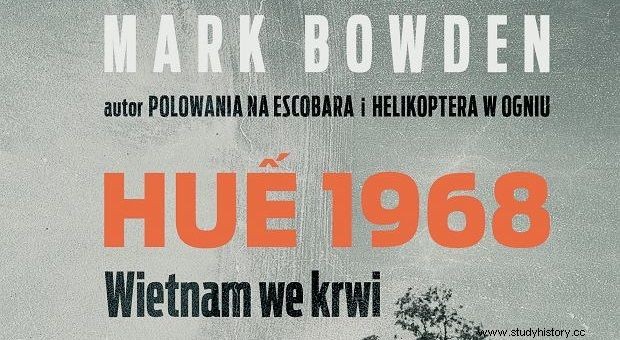Nobody expected the communist attack on Hue. The soldiers of the North took the city in one day - but this was only the beginning of the nearly month-long murderous struggle. By the time the flag of the South fluttered over it again, the old capital of Vietnam was in ruins. How did this landmark battle go?
Hue, the former capital of Vietnam, was inhabited by about 140,000 people at the beginning of 1968, two-thirds of whom lived in the Old Town on the west bank of the Perfume River. South Vietnam's third largest city was located approximately 10 kilometers west of the South China Sea. It was located 100 kilometers south of the Demilitarized Zone, separating the South from the Democratic Republic of Vietnam.
The goal of the communists
Hue was of great historical and emotional significance to the Vietnamese people and would fit perfectly as the temporary headquarters for the new communist "revolutionary government" of the South. It thus naturally became the second - after the capital of the Republic of Vietnam, Saigon - the most important target of the national Tet Offensive in Hanoi, launched on January 31, 1968 . Its purpose was to spark a "popular uprising" and thus bring about the final defeat of the Americans.
The city has not been attacked before. There was almost no army stationed there. One of the few exceptions was the headquarters of the 1st Infantry Division of the South Vietnamese Army, located in an isolated complex in the northern corner of the Citadel. The latter, located in the area of the Old Town, had a square shape and was surrounded by a thick, high embankment, additionally protected by a moat. Its interior, to which nine gates led, was protected by a huge brick wall. It was built in 1802 in a style reminiscent of the Beijing Forbidden City. Within its limits there was a huge Imperial Palace with a magnificent gate ending with an impressive tower and the Tay Loc airport. It was a tourist paradise.
The Old Town bordered to the south with the Perfumowa River, crossed by bridges connecting it with the New Town. It was home to numerous government and military facilities, such as high school, university buildings, city hospital, prison and cathedral. The headquarters of the American Command of the Armed Forces in South Vietnam (MACV) was also stationed there.
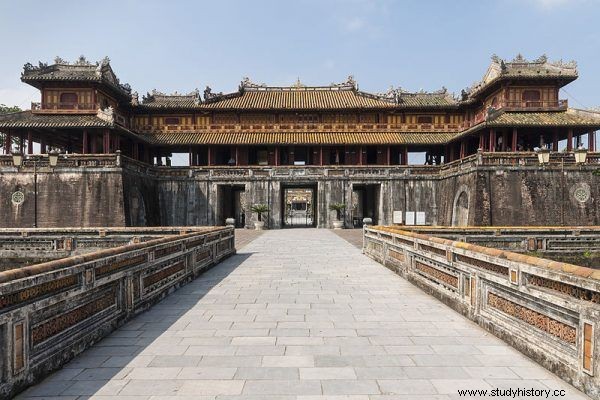
Hue is one of the most important cities of Vietnam, the former capital, full of priceless architectural monuments.
The communists intended to launch a concentrated attack on Hu with the help of two regiments of the Vietnamese People's Army, as well as six local Vietcong battalions and an artillery squadron. Meanwhile, the commander of the 1st DP sensed that the enemies were preparing an offensive operation, but mistakenly judged that the city would not be their target .
First hours of battle
The attack on Hue began on January 31, 1968 at 02.31 with mortar and rocket fire. The first battles took place in Nowe Miasto, where the communists managed to quickly master almost all the main objectives. The exception was the complex (MACV), desperately defended by a handful of Americans. The attack on the Old Town did not quite unfold according to their wishes.
The attackers failed to capture the Tay Loc airfield, manned by elements of the elite South Vietnamese Black Panther company. They also did not intercept the staff of the 1st Infantry Division, which was assisted by the soldiers of the Black Panthers. Nevertheless, assault troops managed to seize the gates of the Citadel and spread over the Old Town.
By 8.00 a.m., when the Vietcong flag was triumphantly hoisted over the main gate of the Imperial Palace, almost all of Hue, with the exception of a few isolated points of resistance, was in the hands of the attackers . Mark Bowden in "Hue 1968. Vietnam in Blood" this is how he described the moment of the communists' triumph:
Sergeant Cao Van Sen did not arrive […] for more than an hour, along with two flag-carrying helpers. They also brought a journalist and camera operator with them to witness this historic moment. It was eight in the morning when the flag was hoisted. Few noticed her at first. The morning was foggy and people […]. However, soon the blue and red flag with a yellow star was visible not only in Hue. The whole world has seen her.
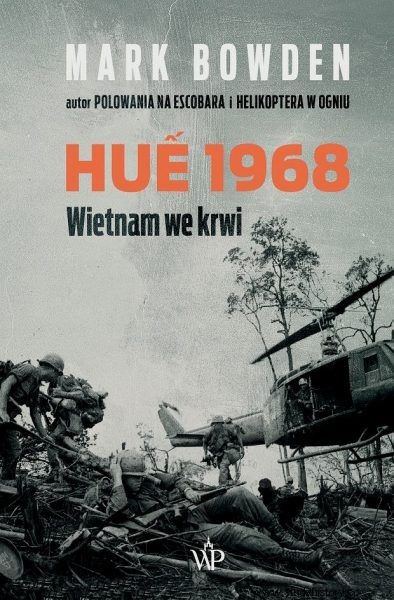
The commander of the 1st DP decided then to call in reinforcements, but most of the units got stuck on the approaches to the Citadel and suffered losses. American troops of the 1st Marine Division, supported by tanks, set out to help the New City from the nearby base in Phu Bai. They managed to break into the MACV complex at 15.15.
The Marines, however, were unable to control the situation in this part of the city or successfully attack the Citadel from the east, through the bridges to Perfume. This required much greater force to be brought into the Hue area than initially thought. They have already grown to several battalions.
City under occupation
Meanwhile, the counterattack of the South Vietnamese Army, supported by new troops, gained momentum and on February 1, troops managed to clear the area of the Tay Loc airfield. It was to, together with the staff of the 1st Infantry Division, become the starting point for an attack on other objects of the Citadel, the reconstruction of which was entrusted to the southern army. The task of the Americans was to cleanse the New Town.
After capturing Hue, the communists prepared for the strike. They built barricades in the streets and fortified houses, and organized the political administration of the city. A new mayor was elected and 2,000 prisoners were released from prisons, of whom about 500 were conscripted into the Vietcong. A Coalition Front for Peace was also created, headed by the left-wing professor Le Van Hao. The population of the city, contrary to the expectations of the communists, did not react enthusiastically to their entry . Moods of apathy and discouragement prevailed.
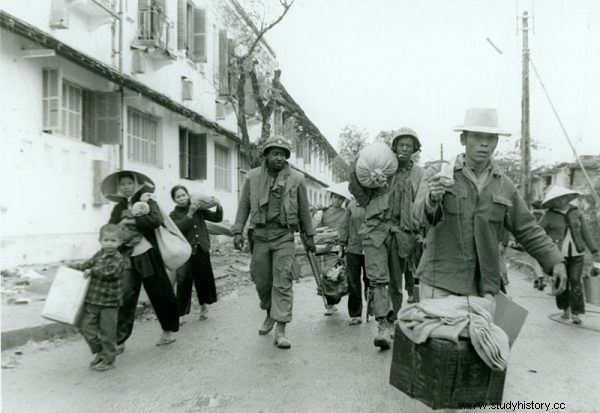
Not all townspeople responded with enthusiasm to the arrival of the communists. During the battle, many people were evacuated from the city.
Members of the South Vietnamese National Liberation Front and the Vietnamese People's Army, and their sympathizers, began their search in the conquered area. They wanted to catch the hiding soldiers of the South, policemen, government officials and their families, as well as foreigners. They often made use of "blacklists" prepared much earlier.
Some of the captured people were liquidated on the spot, and many were invited to re-education courses, from which they never returned. It was estimated that the communists murdered about 2,400 citizens, whom they considered "enemies of the people". Until today, however, there is no reliable data on how the massacre happened and how many people it ultimately affected. Mark Bowden draws attention to the fact that hardly anyone could feel safe in the area controlled by Vietcong and WAL units:
All foreigners were in danger. Three German doctors who taught at the medical academy were shot along with the wife of one of them. Two French Benedictine missionaries, despite their nationality, were also killed; one was shot and the other was buried alive .
Fight for every street
On February 2, a strong American counterattack began in the New Town. Two marines, supported by armored weapons, attempted to recapture the prison building and surrounding facilities. These actions broke down relatively quickly after one of the supporting tanks was damaged by an anti-tank rocket. Eventually, after very heavy fights, the marines reached the university building in the evening.
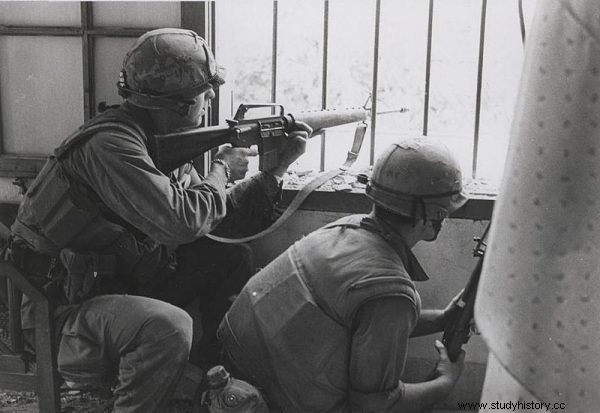
There was a fight for every building and every street.
Even with the support of the enemy's relatively anti-tank M48 Patton tanks and the high firepower of the M50 Ontos tank destroyers (which had six 106mm recoilless guns) operations in Hue were slow and bloody . The columns of soldiers, breaking through the streets towards their targets, encountered, apart from barricades, intense fire from automatic and machine weapons, as well as rockets.
Due to the historic character of the city, the use of direct support aviation and artillery was limited. As a result, in the course of the next six days, only four quarters of Nowe Miasto were cleared. The Americans compensated for these limitations by using Jeeps with 106 mm recoilless guns in the narrow streets. Tear gas grenades were also used to incapacitate the enemy in the course of battles for more buildings.
On February 3, the Marines made little progress, but the next day they managed to capture the IRS building. On February 5, after heavy clashes, the Provincial Administration building was seized. It was a key moment in the battle for the New Town, as it housed the command of the WAL regiment. Soon after, the prison and the police station fell.
On February 6, the resistance of the communists began to weaken markedly. On the same day they began to retreat. Five days later, almost all of the New Town was in the hands of the Americans, although small exchanges of fire continued for the next 12 days. In the fighting for this part of Hue, 38 American soldiers were killed and 320 were wounded. In the streets and in dilapidated buildings, there were the bodies of about a thousand fighters from the North.
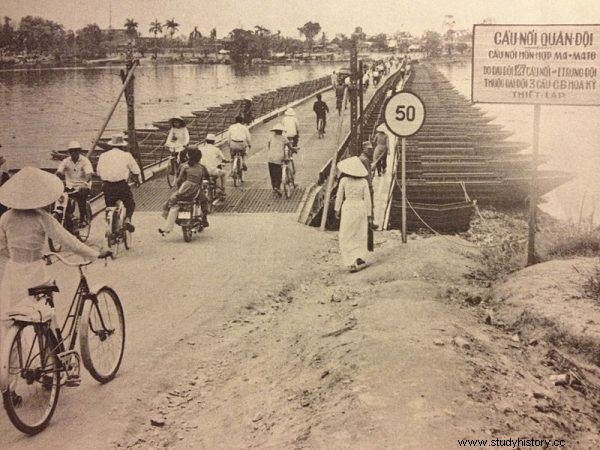
Only a breakthrough in the fighting allowed the Americans to build a pontoon bridge over the Perfume River.
After capturing the New Town, the Americans transferred most of their forces to the Perfume River to support the APW, which is still fighting for the Citadel. Southern troops had by then cleared its northwest edge and were now attacking from the Tay Loc area westward. On the fifth day of the battle, the APW recaptured the gate of An Hoa, however its progress was very slow. Most of the soldiers had only light weapons, which was insufficient to storm the fortified buildings of the Old Town.
Moreover, for many days the enemy was constantly receiving reinforcements at night and counterattacked. Thus, the momentum of the APW offensive began to gradually fade away. Individual units of the southern troops suffered heavy losses and were exhausted, and there was a shortage of food and ammunition. By February 11, the 1st DP regained half of the Citadel, but it became clear that it had reached the end of its offensive capabilities. And although it was a matter of honor for the APW to regain the Old Town, the Vietnamese were forced to ask the marines for help.
Breakthrough
The Americans, supported by Patton and Ontosa, joined the fight on February 13. The breakthrough came two days later, and the following days brought new field profits. When the southern part of the wall was reached on February 23 and the 1st Air Cavalry Division, operating outside the city, pressed hard on the communist external supply corridor, WAL troops began to show the first signs of exhaustion.
Saigon also gave the Americans permission to bomb and artillery fire on the Citadel. This significantly improved the situation and made it possible to build a pontoon bridge on the Perfume River. It replaced the crossings blown up by the communists seeking to isolate the Old Town.
A perceptible weakening of the resistance indicated that the battle was nearing its end. On February 16, the 1st DP intercepted a radio report from the Citadel, informing that the current WAL commander had just been killed by an artillery shell. His successor asked his superiors for permission to withdraw from Hue. However, he received a reply to stick to the end.

Three days later, the last great communist counterattack on Tay Loc airport took place and was bloodily repulsed. On February 24, the soldiers of the AWP recaptured the building of the Imperial Court, after which they regained the palace and at 5.15 am over the Citadel again the flag of the South flashed . After 25 days, the battle ended with the defeat of the North.
Balance of losses
It is difficult to estimate the losses of WAL and Vietcong. In one of the documents obtained it was stated that their balance was 1042 killed and several thousand wounded. This number included one regiment commander, eight battalion commanders, 24 company chiefs and 72 platoon leaders. English-language sources estimated the number of killed enemies at around 5,000. 89 people were taken prisoner.
The U.S. Marines' three battalions, meanwhile, recorded losses of 142 dead and 857 wounded. The APW had 384 killed and 1,800 wounded. The city infrastructure has also suffered a lot. In all of Hue, 80 percent of homes were destroyed. Over 5,800 inhabitants died. Mark Bowden in "Hue 1968. Vietnam in Blood" he summarized it as follows:
As always, the greatest burden of the battle was borne by the civilians . Typically, the number of civilian casualties in Hue is 5.8 thousand. dead, but this is almost certainly an understated number. Many civilians were killed by bombing, artillery fire, or fire from both sides. Many also died in shelters under their own houses, were buried under rubble [...].
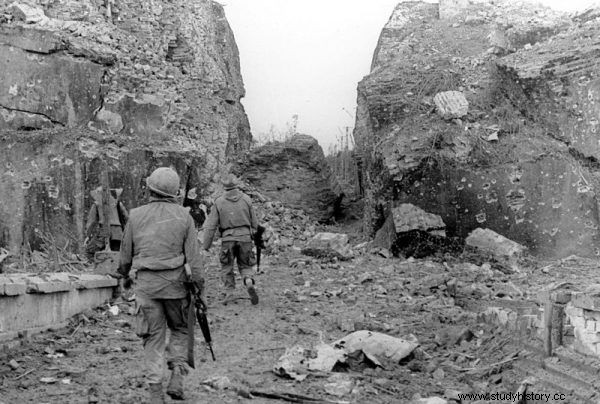
The city was almost completely destroyed during the fighting.
Without careful research, it was impossible to establish the identity of the bodies found in the mass graves. The huge number of the dead required quick burials. To the thousands of civilians who died accidentally, add those who died in the executions.
The Battle of Hue was undoubtedly the bloodiest battle fought during the Tet Offensive and one of the most fierce of the entire Second Indochina War.
Buy the book cheaper on Empik's website:
